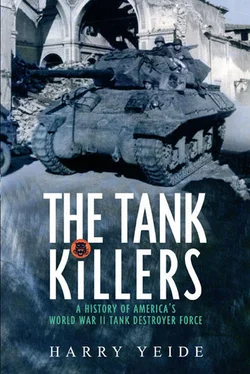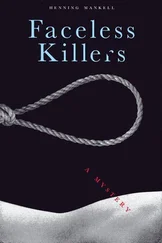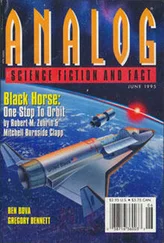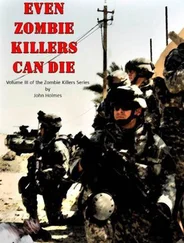On 7 October, Marshall approved the War Department’s estimate for antitank battalion needs and suggested the immediate activation of sixty-three battalions. He also decided to rename the units “tank destroyers” for psychological reasons. 23
The final phase of the GHQ maneuvers took place in North and South Carolina in November 1941 and pitted 865 tanks and armored cars from I Armored Corps against First Army’s 764 mobile antitank guns and 3,557 other pieces of artillery. Men from the 1st Provisional Antitank Battalion—later the 601st Tank Destroyer Battalion—would remember the maneuvers for the cold and rain on some days and the dust on others, as well as the first-ever issue of C-rations. 24First Army had received the three GHQ antitank groups and organized three more “Tank Attacker” (TA) groups of its own. TA-1 included the 93d Antitank Battalion, which was outfitted with experimental self-propelled guns constructed from 75mm field pieces mounted on halftracks. In addition to the mix fielded by the antitank groups during the Louisiana maneuvers, it also had an antiaircraft element and observation planes. The tank forces suffered tremendous losses during the wargames. The 1st Armored Division was ruled destroyed, and 983 tanks were “knocked out,” 91 percent by antitank guns. In the most startling incident, TA-1’s self-propelled guns on 20 November charged the bivouac of the isolated 69th Armored Regiment and, taking full advantage of the rules, “annihilated” the formation. 25
* * *
The Armored Force drew solid lessons from its failures and reorganized the armored divisions to provide more infantry for combined-arms operations, and to reduce the proportion of vulnerable light tanks. McNair and his supporters among antitank thinkers, on the other hand, concluded that they had solved the puzzle. On 27 November, the War Department ordered the activation of fifty-three tank destroyer battalions under GHQ control. On 3 December, it removed all existing antitank battalions from their parent arms, redesignated them tank destroyer battalions, and subordinated them to GHQ as well. Battalions originating in infantry divisions received unit numbers in the 600 series, while those from armored divisions and GHQ field artillery units were given designations in the 700s and 800s, respectively. 26
Despite the subordination of the new tank destroyer units to GHQ, the Army initially associated the battalions with their parent divisions as they were activated in December. The 601st through the 609th, for example, were so designated on the basis of co-location with the 1st through the 9th Infantry divisions of the Regular Army. Those attached to the mobilized National Guard divisions were numbered 626th through 645th. These associations did not last long in most cases. 27
The 27 November War Department directive also established a Tank Destroyer Tactical and Firing Center at Fort Meade, Maryland, to oversee the formulation of doctrine, draft field manuals, determine the organization of the separate battalions, and organize a common training program. Lieutenant Colonel Bruce of the Planning Branch assumed command, a job that would bring him two stars in nine short months. 28With the reorganization of the War Department in March 1942, McNair became the commanding general of Army Ground Forces (AGF). Bruce’s center became a separate Tank Destroyer Command, based at Camp Hood, Texas, joining armor, antiaircraft, and airborne as quasi-arms of the Army. Many officers nevertheless questioned whether tank destroyers merited such separate status, and the Armored Force lobbied to take control over training. In July, McNair acknowledged that the Tank Destroyer Command actually lacked command authority similar to that of the Armored Force, and he in August redesignated Bruce’s operation a center again. 29
At this time, there were roughly seventy tank destroyer battalions scattered around the country, all looking to the center to end widespread confusion over organization, tactics, and training. To meet this need, the center’s powers to ensure uniform standards in all tank destroyer units and its physical training facilities expanded substantially in late 1942. 30
Crafting a Tank Destroyer Doctrine
The Tank Destroyer Center/Command formulated a doctrine that embodied the lessons that the drafters thought they had learned in 1941. The doctrine also seemed to embody the character of center commander Bruce. “A.D.” Bruce had graduated from Texas A&M in 1916 and shipped overseas as a provisional lieutenant. He rose to command a machine gun battalion in the 2d Infantry Division and fought in every one of its major engagements. Bruce’s fighting style speaks for itself: He returned with the Distinguished Service Cross, the Legion of Honor, the Croix de Guerre with two palms and a star, and two or three other decorations. Bruce was a tall, rugged man who punctuated his conversation with energetic gestures. When he spoke of striking a blow, he would slam his fist into the palm of his other hand with a force that jarred the office. Bruce was impatient with bureaucracy and traditionalism. 31
The tank destroyers would rely on mass, mobility, firepower, and aggressiveness to accomplish their mission. Indeed, the training notes written by the 93d Antitank (redesignated 893d Tank Destroyer) Battalion—which had executed TA-1’s fabled destruction of the 69th Armored Regiment during the Carolina maneuvers—became the interim guidance for new tank destroyer battalions while an official doctrine was under development. 32
In a 1942 interview, Bruce described his vision. “The autocrat of the ground battle in this war has been the tank. With the tank destroyer we think we have its number. The destroyer’s gun and mount don’t have the tank’s armor, but its crew commands greater speed, visibility, and maneuverability, and at least equal firepower. It can pick the time and place to deliver its punch and then hightail it to a new position to strike again. One good tank destroyer can be produced for materially less than the cost of a tank, and in far less time and with less critical materials. And by using tank destroyers to stop enemy tanks, you leave your own tanks free to dash through and spread hell among the enemy.” 33
The new doctrine was formalized in FM 18-5, Tank Destroyer Field Manual: Organization and Tactics of Tank Destroyer Units , distributed to formations as a draft in March 1942 and published in June. The manual proclaimed that the destruction of hostile tanks was the sole mission of the unit. It described the likely foe as a large and fast mass of tanks—most of them light—operating more or less independently of infantry and artillery. The prescription offered was:
Tank destroyer units are employed offensively in large numbers, by rapid maneuver, and by surprise…. Offensive action allows the entire strength of a tank destroyer unit to be engaged against the enemy. For individual tank destroyers, offensive action consists of vigorous reconnaissance to locate hostile tanks and movement to advantageous positions from which to attack the enemy by fire. Tank destroyers avoid “slugging matches” with tanks, but compensate for their light armor and difficulty of concealment by exploiting their mobility and superior observation….
The characteristics of tank destroyer units are mobility and a high degree of armor-piercing firepower, combined with light armor protection; strong defensive capacity against attacks of combat aviation; and flexibility of action permitted by generous endowment of means of communication. 34
FM 18-5 indicated that tank destroyer battalions would operate as mobile reserves and not as part of the front-line defense. The tactics prescribed presumed that large tank destroyer forces would swarm to the point of an attack and maneuver to strike at the enemy’s flanks—from ambush if at all possible. Reconnaissance would be key both to finding the enemy and to identifying primary and alternate firing positions. Individual tank destroyers (TDs) would fire several rounds and then displace to another position before firing again. The manual suggested that this activity would take place semi-independently of other combat elements but suggested vaguely that units should call for help if confronted by enemy infantry. 35
Читать дальше







